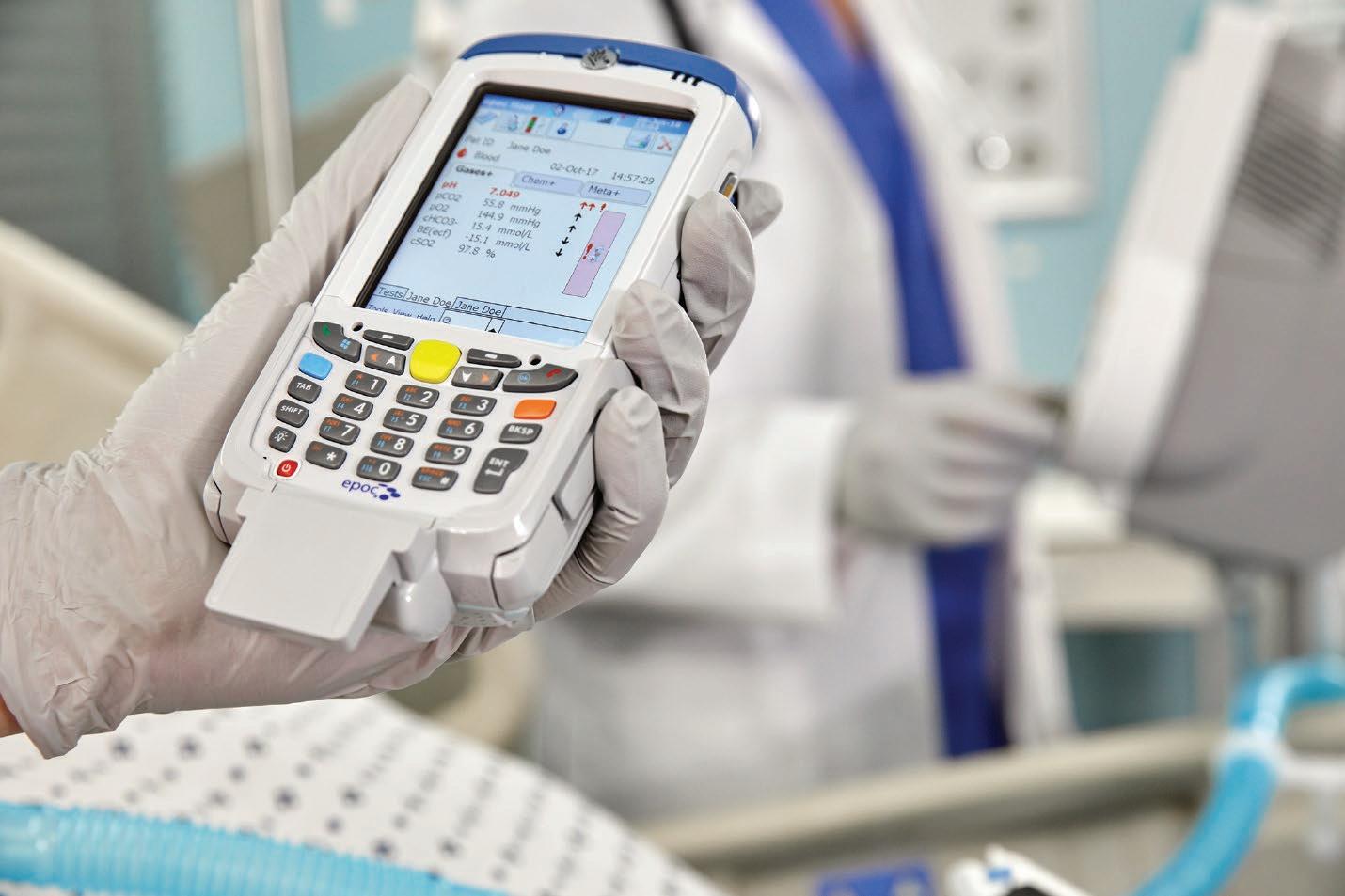
6 minute read
Clinical Guidelines and Recommendations for Blood Gas Analysis
from Improving the Diagnosis and Monitoring of Critically ill Patients and the Role of Blood Gas Testing
Sophie Laurenson, BSc. BSc. (Hons.), PhD. (Cantab), EMBA, MRSNZ
The American Association for Respiratory Care (AARC) published Clinical Care Guidelines for Blood Gas Analysis and Hemoximetry in 2013, recommending analysis to evaluate the oxygenation and acid-base status of patients presenting in acute settings.
Introduction
Clinical guidelines are statements issued by healthcare organizations, government entities, or non-governmental organizations that include recommendations proposed to optimize patient care. Guidelines are developed by disease area or discipline specialists, informed by systematic reviews of clinical and scientific evidence 44 . An assessment of the potential benefits and harms of alternative interventions forms part of clinical guideline formulations. The application of blood gas analysis to the diagnosis, monitoring, and prognosis of various disease areas has been addressed by numerous clinical guidelines for cardiorespiratory and metabolic disease management. In this article, the specific clinical guidelines addressing the use of blood gas analysis in critically ill patients is summarized.
Reference Measurements and Interpretation
Interpretation of blood gas results plays an essential role in the diagnosis and treatment of patients with a range of critical conditions. However, the causes of underlying deviations in blood gas values may be multifactorial and complex to interpret. Although both venous and arterial blood specimens can be used for blood gas analysis, their results should not be used interchangeably. Venous blood has a lower pH level, reduced oxygen, and increased PaCO 2 levels compared to arterial blood 45 . The respiratory system and the metabolic system (primarily the renal system), are responsible for maintaining pH homeostasis at pH = 7.35 to 7.45. Altering the respiratory rate can rapidly compensate for variations in blood pH levels to restore homeostasis. The metabolic system regulates hydrogen ions (H + ) and bicarbonate (HCO 3 - ) levels through excretion, a process
Proper sample handling is critical in blood gas testing
that may take hours or days to restore balance. The reference levels for carbon dioxide (PaCO 2 ) are 35 to 45 mmHg, and oxygen (PaO 2 ) are 83 to 108 mmHg in adults 46 . However, reference intervals may vary between institutions based on population differences. Both PaCO 2 and PaO 2 are lower in infants, and both are affected by altitude (measured as meters above sea level). Abnormalities in PaCO 2 indicate a primary respiratory condition, whereas variation in bicarbonate levels indicate a metabolic disease. However, interpreting pH, PaCO 2 , PaO 2 , and HCO 3 - levels in conditions resulting from a combination of respiratory and metabolic issues is often challenging. This challenge is amplified when considering any compensation mechanisms that may be working to restore homeostasis in critically ill patients 45 .
The American Association for Respiratory Care (AARC) published Clinical Care Guidelines for Blood Gas Analysis and Hemoximetry in 2013 47 . These guidelines make the following recommendations based on the Grading of Recommendations Assessment, Development, and Evaluation criteria:
“BGA (blood gas analysis) and hemoximetry are recommended for evaluating a patient’s ventilatory, acid-base, and/or oxygenation status. BGA and hemoximetry are suggested for evaluating a patient’s response to therapeutic interventions. BGA and hemoximetry are recommended for monitoring severity and progression of documented cardiopulmonary disease processes. Hemoximetry is recommended to determine the impact of dyshemoglobins on oxygenation. Capillary BGA is not recommended to determine oxygenation status. Central venous BGA and hemoximetry are suggested to determine oxygen consumption in the setting of early goal-directed therapies.”
Blood gas analysis is recommended to evaluate the oxygenation and acid-base status of patients presenting in acute settings. Following an initial assessment, ongoing serial measurements may be used to monitor patient progress in critical care settings and to gauge the effectiveness of interventions such as supplemental oxygen treatment.
The AARC 2013 guidelines also detail best practices for sampling, handling, and analyzing blood gas test results. Blood gas analysis is prone to errors emanating from the preanalytical steps to control of the analytical instrument and testing process. Sources of error may include sampling errors, abnormal or miscalculated F i O 2 , barometric pressures, and temperature variation 48 .
Whole blood is the sample of choice for gas analysis, although arterial and venous blood differ with respect to PO 2 measurements. Healthcare professionals that collect arterial or venous samples should be aware of specific sample collection and handling requirements. Sample preparation and dilution with saline or heparin anticoagulant have been observed as sources of potential error. The transport and analysis of samples should be prompt. The contamination of anaerobic samples by air can cause discrepancies in PCO 2 measurements and has been observed in samples transported using pneumatic tube systems. Drawing blood samples of adequate volume, using appropriate syringes without introducing air bubbles are all recommendations for minimizing errors.
To ensure accurate results, the storage temperatures for blood gas samples before analysis is critical. Variation in temperature can result in inconsistencies in both PaO 2 and O 2 saturation levels. It is also worth noting that certain pathologic conditions such as hyperleukocytosis and dyshemoglobinemias can also contribute to discrepancies in PaO 2 and O 2 saturation.
Acute Respiratory Distress Syndrome (ARDS)
Acute respiratory distress syndrome (ARDS) is an inflammatory lung condition resulting from alveolar injury consequent to inflammation from either pulmonary or systemic origins. ARDS is characterized by hypoxemia occurring without heart failure (HF). Bilateral pulmonary infiltrates are observed by chest imaging.
The diagnosis of ARDS is reliant on blood gas analysis results. The Berlin definition 9 includes the presence of hypoxemia defined by the ratio of the partial pressure of arterial oxygen (PaO 2 ) to the fraction of inspired oxygen (F i O 2 ) (PaO 2 /F i O 2 ). This measure of oxygenation is applied to classify ARDS as mild (PaO 2 /F i O 2 of 200–≤300 mmHg), moderate (PaO 2 / F i O 2 100–≤200 mmHg), or severe (PaO 2 /F i O 2 ≤100 mmHg). Although the PaO 2 /F i O 2 is easy to calculate, it can vary with differing positive end-expiratory pressure (PEEP) 49 and tidal volumes 50 . An alternative to measuring PaO 2 / F i O 2 is the oxygenation index (OI). OI is defined as the product of mean airway pressure and F i O 2 , divided by PaO 2 . The mean airway pressure accounts for variations in PEEP, making this a more reliable indicator of respiratory function 51 .
Conclusion
Blood gas analysis is essential for the diagnosis and treatment of patients with a range of critical conditions. However, the underlying pathologies that contribute to abnormal blood gas values may be multifactorial and complex to interpret. Reference intervals for pH, PaCO 2 , PaO 2 , and HCO 3 - are all published, although institutions may use different values and interpretation guidelines based on local requirements. The American Association for Respiratory Care (AARC) published Clinical Care Guidelines for Blood Gas Analysis and Hemoximetry in 2013, recommending the use of blood gas analysis in specific clinical settings. They also include best practices for sampling, handling, and analyzing blood gas results. Further, recommendations for using blood gas analysis for the diagnosis and management of specific cardiopulmonary diseases have been published by many organizations. Blood gas results have a vital function in the diagnosis of ARDS.
Blood gas analysis is recommended to evaluate the oxygenation and acid-base status of patients presenting in acute settings. Following an initial assessment, ongoing serial measurements may be used to monitor patient progress in critical care settings and to gauge the effectiveness of interventions such as supplemental oxygen treatment







